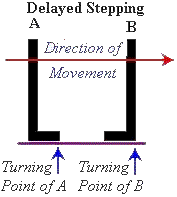
Email : [email protected] Or General Mailer
 |
Jai Chavan's
"Dance-Sport" Email : [email protected] Or General Mailer |
| Back || Master Pg. || Overview || Contents || Alphabetical Index || Home || Next |
Delayed Stepping
 |
This example also explains the necessity of giving subtle resistance to the forward movements of a dancing partner, and the trick to achieve the unhurried, "lazy" and smooth stepping movements to a walk, which is especially required in Foxtrot and preferred in almost all the other dances. |
Dancer A and Dancer B when moving in the Direction of Movement
as indicated by the red arrow, the turning point of the rolling
foot occurs as the Turning Point 'A' and 'B' as indicated with
the small blue arrows. For the Dancer A, it's the forward
movement with a push and near by there is the toe joints which
gives a better control as against the Dancer B who will simply
"heel over" and move backward. Thus the dancer B need
to give a subtle resistance to the forward moving dancer A to
maintain some control when balancing on the heel.
Thus in a dance the Dancer A would move by "bulldozing"
forward to the Turning Point A, and give a slight pause. At the
same time the Dancer B who is moving back and simultaneously
giving resistance reaches the Turning Point B, at which point the
body just tends to "heel over" and starts to fall back.
Precisely at this movement both the dancers, but more so the
partner moving forward gives a strong push. This will result in
the two dancers to flow smoothly into the step. Sometimes it's
possible to get a slight thigh contact with either or both the
feet just before the "heel over", which would avoid a
dancer from rushing into a push force.
After the push for the step, the Dancer A would land on the heel
first. The resulting forward movement of the body to come to
normal position is not much when the vertical body-weight force
acting through the centre of gravity of the Dancer A and the
reaction force are in line near the heel, as compared to the
partner moving backward. For Dancer B the toes would touch first
and the distance from the toe to near the heel needs to be
covered such that the vertical forces of body-weight through the
centre of gravity of Dancer B and the Reaction force cancel each
other out. This would necessitate more body movement as compared
to that of the Dancer A to come to the relaxed position near the
heel.
This necessitates on the part of the dancer moving back to step
slightly later than the one moving forward so as to maintain the
gap between the toes more or less constant.
| Back || Master Pg. || Overview || Contents || Alphabetical Index || Home || Next |